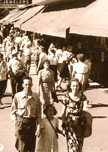|
|---|
last update: October 23rd, 2007
The Decline of Main StreetA UTAH STORIES INVESTIGATION: 
By 1965 Downtown began to show signs of disrepair and neglect. As malls had gained greater popularity, shoppers no longer relied on Downtown Salt Lake City as the only major retail destination. Already the Cottonwood Mall with its anchor, J.C Pennies were tremendously popular with shoppers. Keith O'brien department store followed the suburban trend and opened shop in Sugar House. City Planners and leaders began to consider ways of maintaining downtown as the "heart of Salt Lake." The Downtown Merchant's Association also realized that more must be done so that downtown could, "keep up with the suburbs." The following collection accounts for the beginning of what would be a series of steps that would slowly transform much of historic Salt Lake City into 1.2 million square feet of indoor retail shopping. Their decisions were made in attempt to "modernize" the city for the 21st Century. In this effort they began to copy suburban shopping trends by tarring down the old and historic and replacing it with more modern designs. The decision in the effort of beautification and modernization was to prohibit all overhanging sidewalks signs. The following Articles appeared in the Salt Lake Tribune and the Desert News between 1965-1982. These articles are photograph reproductions courtesy of the Utah State Historical Society. These clippings were donated to the state archivists by private individuals who kept files on the transformation Salt Lake City was undergoing at the time.
An architect from the University of Utah points out that the disarray of the signs in Salt Lake make it actually an ugly city. This is a odd claim because there isn't a great city in the world that doesn't allow of overhanging signs. However, Salt Lake City Planners pass a law restricting all overhanging signs on all city streets. This would cost local merchants thousands of dollars and remove many merchants primary means for advertising.
This article shows how the sidewalks in and around downtown are in serious need of repair. The repair and improvement projects that would result from this small problem would cause much greater problems for merchants, whose customers were unable to park or walk to their businesses for close to an entire year.
November 14th, 1968 The downtown planners Second Century plan receives some new life as planners recognize that something must be done to revitalize downtown. In this effort they decide to hire an architecture firm out of Chicago, Barton Aschman.
The first big blow to local merchants on Main Street is the result of downtown Barton Aschman's suggestions to "beautify the street in order to preserve downtown as the traditional market-place for the city". More parking facilities and wider sidewalks are the two primary recommendations of the city planners by Barton Aschman.
However, Barton Aschman instead makes plans to make the sidewalks wider and cut into the on-street parking. Subsequently parking was reduced by forty-percent with former angled parking (see photograph at the top of the page )replaced with parallel parking. Thus, during and after construction many local merchants saw their customers disappear. For the next six years more "beautification projects" would continue and Mr. Schubach was always the most outspoken critic of the projects. Businesses such as Pinbrokes, Baker shoes and the Pinecone Cafe couldn't survive and they closed their doors for good on Main Street. Planners would suggest that these businesses were already suffering and their fate was inevitable.
1970: "Contradictions Mark Downtown Scene" August 7th, 1970 The Deseret News While some buildings are going up others are crumbling. Sidewalks are in disrepair. This article points out that across the nation many central downtown business communities are failing some are still still doing well.
|